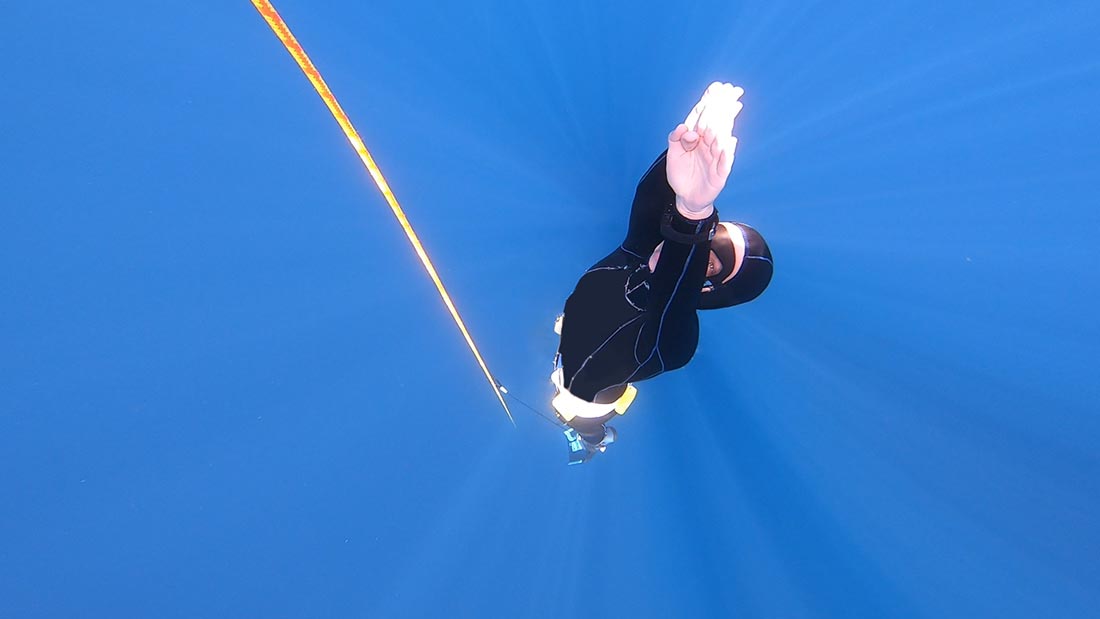
Freediving: -50 meters on a single breath
Jelena Erakovic is the ADVANS Eastern Europe and ELSYS America Marketing Manager. Outside of Work, she is fond of freediving. Let’s follow Jelena in her fascinating underwater adventures, on one breath of air.
How did everything start? By the way, in my generation in France, we all discovered freediving with the movie the Big Blue 😊. Have you seen it?
Of course, I have. However, for me it all started when I was 3 years old and learned first how to dive instead of how to swim, which confused my parents a little bit as they carefully watched out for me not to drown. Thank you mum and dad, you are the best!!!
I also trained swimming for many years, 6:30 am morning sessions, winter and summer, circles underneath eyes from googles, messy hair and always hungry, what not to like about it? Kept swimming until today, somehow water just gets under your skin, swimmers will for sure understand what I am talking about.
Freediving entered my life not so long ago, approximately 4 years ago. As an avid sea – ocean – water lover, someone that loves sailing and open water swimming it came naturally. It opened a whole new world to explore.
What do you feel when doing this activity?
It’s a great and at the same time very complex question. Overall, I feel embraced by the ocean, incredible feeling of serenity and freedom. The most interesting sensation is a freefall. It is a point of negative buoyancy, when you stop finning downward, and only allow the force of gravity to draw you deeper.
Freediving is a mental game as well, you need to control your emotions, your thoughts, and your body. All these activities are consuming the precious oxygen; therefore, we need to be super conscious of everything that is happening around and inside of us. Moreover, we need to have absolute control of ourselves and be well informed about what is happening in our system. For instance, what are the signs of danger? Should I go for a personal best or turn around and fin towards the surface? When do the diaphragm contractions become dangerous?
Did you know that diaphragm contracts to send a signal to our brain that CO2 is building up in our system and we should exhale? Did you know that when contractions start you still have enough oxygen in your blood to stay double, even triple the time you have already been underwater? And that is the moment when real mental game begins. You need to be perfectly calm and rationalize what is happening to yourself so that the brain doesn’t start to cry like a little baby “Get me out of here!!!”.
Second difficult moment is when you are low on oxygen reserves and high on CO2, to keep much needed focus and spot any signs of weakness and avoid potential samba (1) or black out( 2). General signs are blurred vision, feeling no more muscle pain, slowing down, and having uncontrolled, irregular pace or slow movements, etc. Therefore, you need to learn how your body functions.
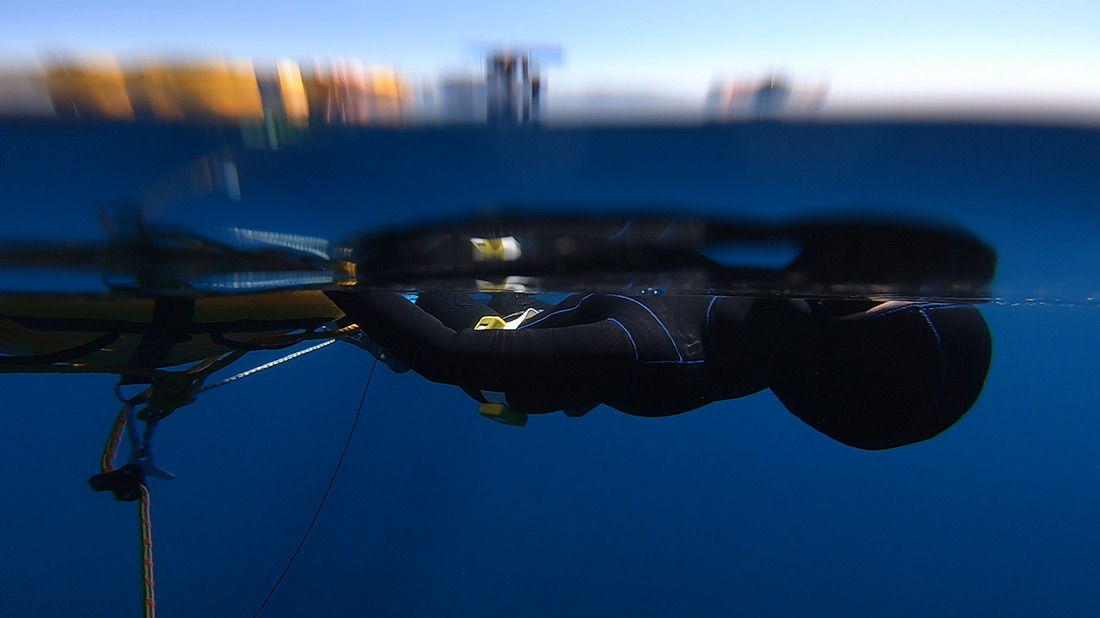
Why do you like it?
It provides me with a rare opportunity to explore underwater world on one breath of air, observe my surroundings and if lucky encounter sea animals and mammals. This is possible because we don’t make almost any noise as compared to scuba divers. Furthermore, great range of movements and speed allows you to reach the bottom supper fast and come back to surface easily. People are often surprised when they realize that freedivers don’t decompress, no need for it.
Science behind freediving is fascinating, as we, humans move limits of what is possible, each time we discover more and more. Few facts:
MDR is Mammalian Dive Reflex which activates when we submerge our face in water, water-sensitive receptors located around our cheeks, mouth, and eyes relay information to brain autonomic nervous system. This causes bradycardia (3)and peripheral vasoconstriction(4). Blood is removed from limbs and all other organs except the heart, lungs and brain, creating heart-lung-brain circuit that allows mammals to conserve oxygen and reduce risk of barotrauma. Humans are mammals.
Air pressure decreases with altitude and water pressure increases with depth. Of course, water is denser than air, so pressure increases more rapidly as you descend.
For instance, as the pressure increases the volume of air in our lungs decreases. On surface is 1 ATM(5) and our lungs have 100% capacity, at 2 ATM (-10m) lungs are at 50%, at 3 ATM (-20m) lungs are at 33%, at 4ATM (-30m) lungs are at 25%, at 5ATM (-40m) lungs are at 20% and so on.
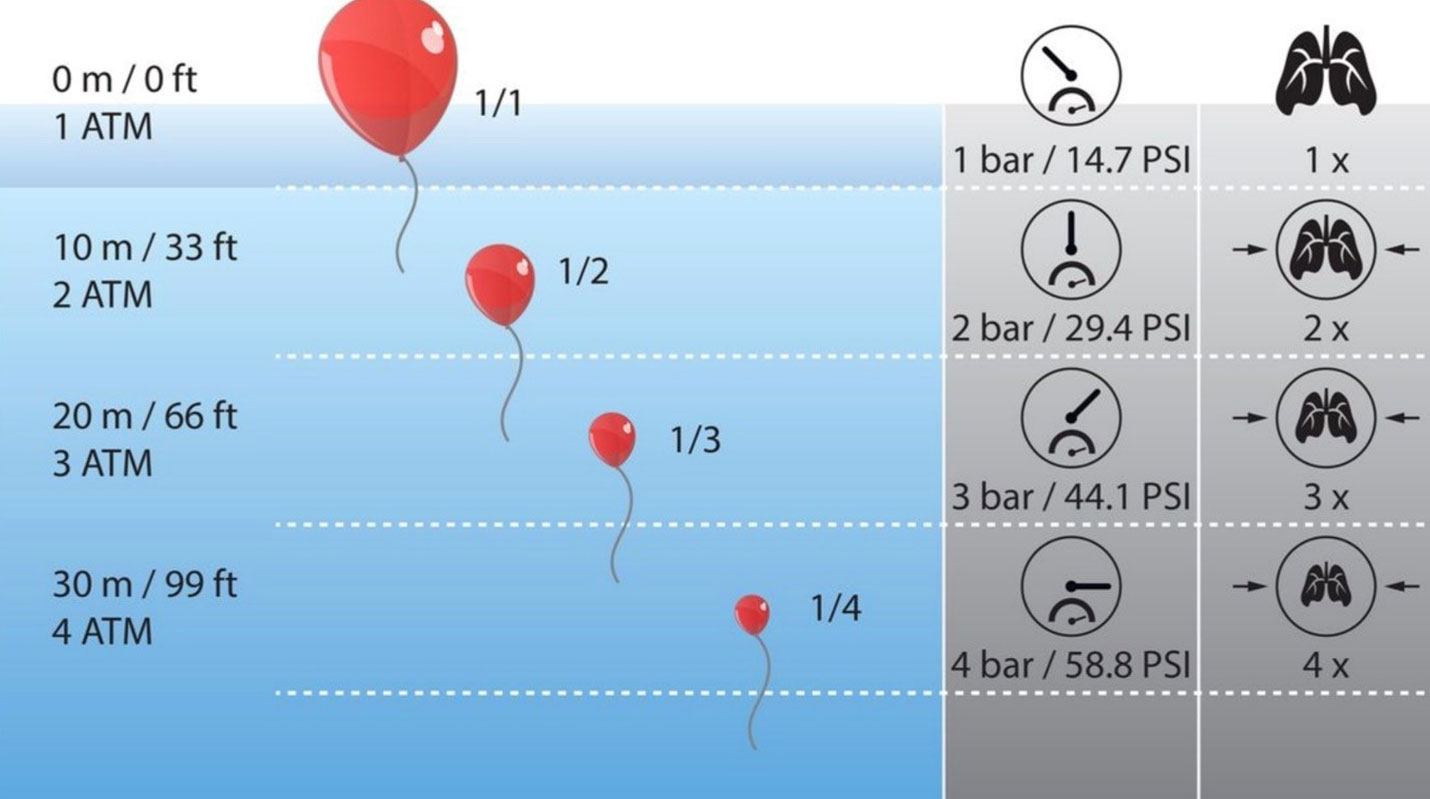
Image Source: SSI Course
The magnificent natural system, described above, allows freedivers to reach fascinating depths and resurface safely. Merely 50 years ago scientists and medics believed it was against every law of nature for humans to reach 30 meters of depth. Today, the world record in men category of CWT discipline is 131 meters and in women category, the same discipline 114 meters. Access all results.
However, it doesn’t come without a risk.
At the end it is a challenge. And with every challenge undertaken, we learn, we change, and we grow.
Have you ever been afraid while freediving?
Honestly, no. Firstly, I love water profoundly and I feel like I am where I belong. Secondly, I understand the science behind the freediving as well as signals my body sends me. Last but certainly not least, I have experienced dive buddy I can trust. If anything goes wrong, a dive buddy is crucial for your survival, and it can easily turn bad. A skilled and trusted dive buddy can save your life. For instance, if you black out in shallow water your glottis(6) will automatically close air ways and hold it for 1 minute before water enters your lungs. More than enough time to save someone and provide help. Rule number one: Never dive alone!
Being relaxed and calm underwater, being able to keep your emotions and different impressions under control is mandatory to be able to enjoy and progress in freediving. Our mind likes to play tricky games with us in such scenarios, bringing up doubts, concerns, the biggest and the craziest fears on stage.
Being well educated, following rules and certain protocols is in my opinion mandatory. This is something that can easily draw a line between successful dive and black out, or unfortunately fatality. I have a privilege to learn from one of the best in the world, my coach and ocean dad, Martin Zajac. I was lucky to meet him and his daughter Jindřiška Zajacová during freediving course on island Pag, Croatia where he was a special guest instructor. From that moment on, we dive together 😊 Great expeditions, training camps and courses from Egypt to Mexico, every recommendation for Apneaman! I have so much to learn, I have barely scratched the surface.
What is your best memory from freediving?
Hard to pick one honestly. If I had to pick one it would be the one that happened at São Nicolau, Cabo Verde when I saw for the first time yellow-fin tunas weighting 70+ kilograms, cruising 2 meters from me. Typical for tunas is to fly by like a torpedo and disappear almost as soon as you notice them, so this was a super rare opportunity! So much, that even locals where surprised.
Second best memory is the whale song I heard while being underwater practicing depth breath holds. Simply mesmerizing, you need to experience it.
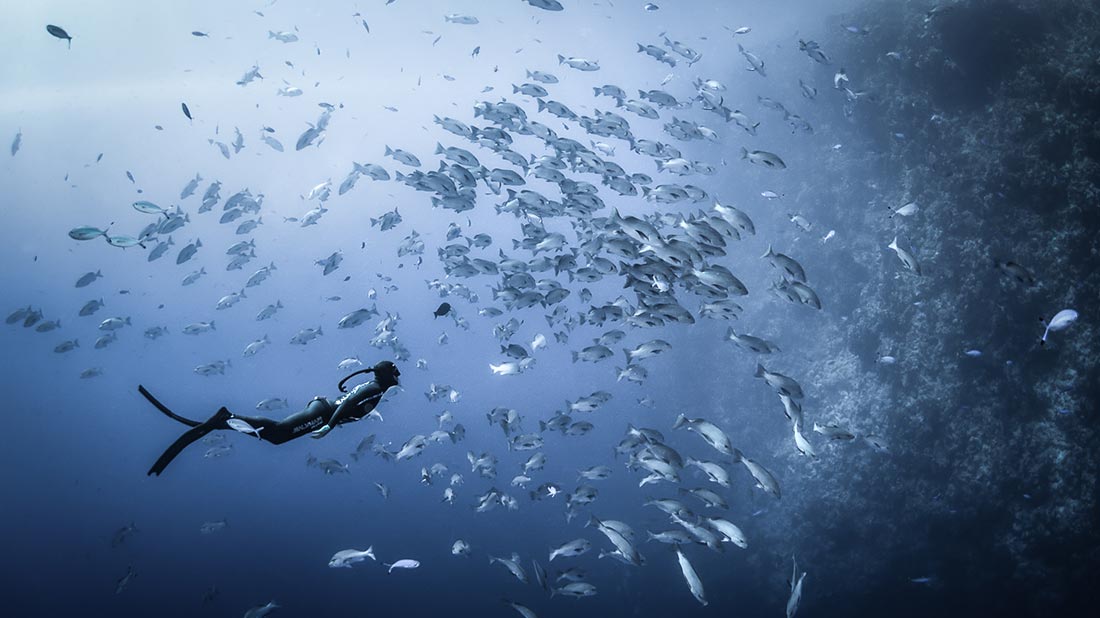
Martin Zajac leading Apneaman expedition Photo by: Apneaman
What have you accomplished?
Freediving is something you should really enjoy and be grateful for every given opportunity to observe and experience underwater world. It requires consistent and hard training sessions, specific nutrition, and a lot of dedication, especially if you don’t live by the sea. Chasing numbers should not be the main goal in recreational freediving, rather rich experience and learning process. It can easily become super dangerous when fixation on reaching certain numbers take over and room for mistakes increases.
My personal bests, so far, are 😊 5:46 minutes of static apnea, which is basically just chilling submerged in water, doing nothing. I even keep my eyes closed to preserve as much oxygen as possible. Next discipline is a dynamic apnea, practiced usually at the pool measuring how far you can dive with or without fins on a single breath of air, at which my personal best is 150 meters with fins. The most time I have spent in dynamic apnea was 3:45 minutes of total dive time. My favorite disciplines are related to deep diving, with current results of 50 meters FIM(7) and 47 meters CWT(8).
What are your plans for the coming months?
Slowing down with eating raclette. Starting again with intensive freediving trainings at the pool, pacing down CrossFit sessions and focusing on CO2 tolerance and apnea endurance to get ready for upcoming training camp in Sharm El Shaik, Egypt. Also, increasing food supplements intake and modifying eating plan to support the activity.
If everything goes smoothly, afterwards, I will start preparation for taking Instructor course at Apnea academy run by one and only Umberto Pelizzari.
If someone would like to try freediving, it would be my pleasure to introduce you to the magnificent underwater world exploration on one breath of air.
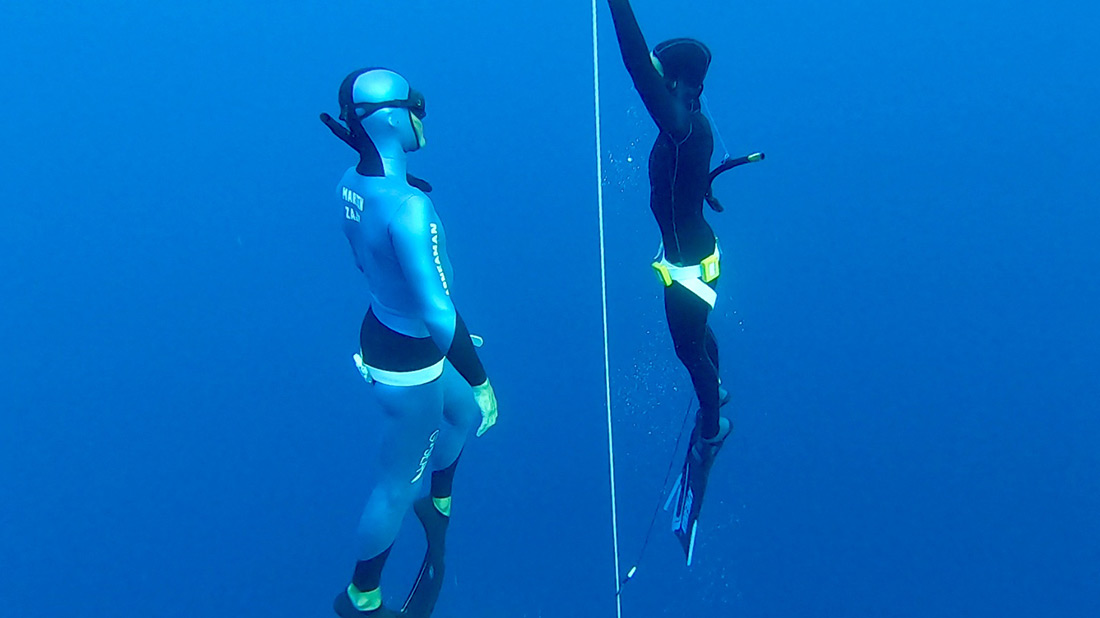
Jelena Erakovic and Martin Zajac deep dive buddy checkup
(1) Samba is a loss of motor control and uncontrolled movement in the body, it can occur in 15 seconds after resurfacing due to not having enough oxygen in your brain. (back to text)
(2) Black out is a loss of consciousness caused by a decrease of oxygen supply to the brain towards the end of the dive. It can occur when resurfaced or a few meters before reaching the surface. (back to text)
(3) Bradycardia(back to text)
(4) Peripheral vasoconstriction (back to text)
(5) ATM is abbreviation for a standard atmosphere, it is the unit of pressure equal to the average atmospheric pressure at sea level. Specifically, 1 ATM = 101,325 pascals.(back to text)
(6) Glottis is the area between the vocal cords, which connect the airways in your throat to your lungs. (back to text)
(7) FIM – Free immersion apnea – you pull yourself down on set line (rope), no fins, and you also pull yourself up. (back to text)
(8) CWT – The diver descends and ascends vertically along a dive rope using the propulsion of a monofin or bi-fins and/or arm strokes. The dive rope cannot be used for pulling and the diver is only allowed to hold on to it once, while turning at the bottom and preparing for the ascent(back to text).

Jelena Erakovic, as we know her at work 🙂